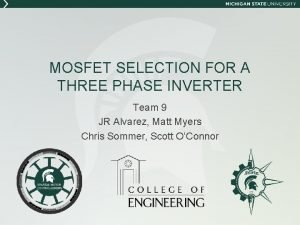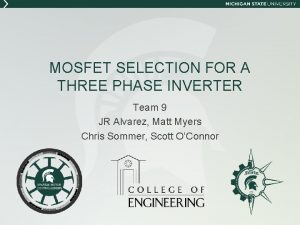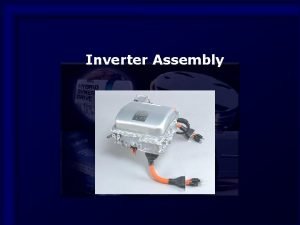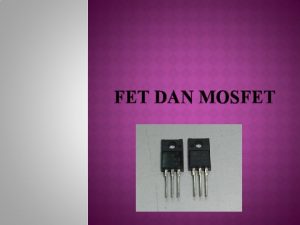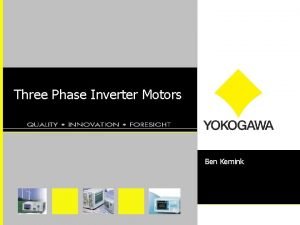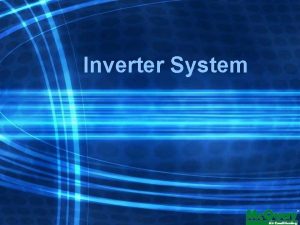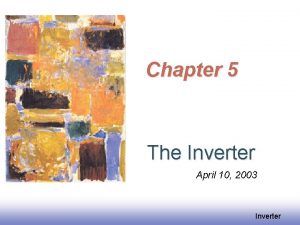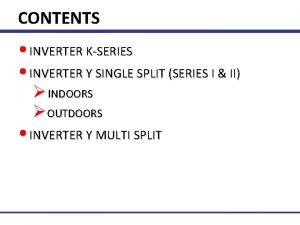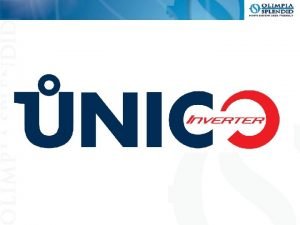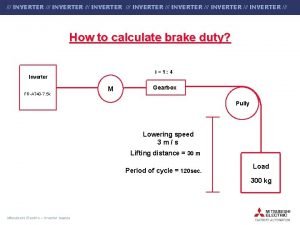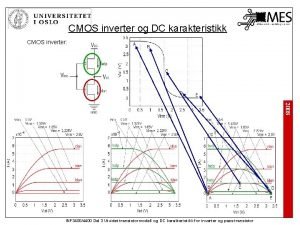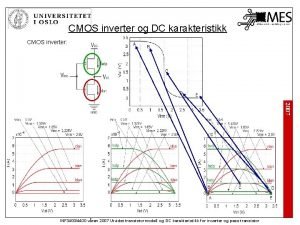MOSFET SELECTION FOR A THREE PHASE INVERTER Team















- Slides: 15

MOSFET SELECTION FOR A THREE PHASE INVERTER Team 9 JR Alvarez, Matt Myers Chris Sommer, Scott O’Connor

Table of Contents • • • MOSFETs Overview Three Phase Inverter Gate Capacitance Switching Losses Breakdown Voltage On Resistance Heat Dissipation Insulation Heat Sink Package Type Mounting

MOSFET Overview • Switching Device that acts as a voltage controlled current source. • A change in the gate to source voltage causes a change in the drain to source current. • To increase the current MOSFETs can be put in parallel.

Three Phase Inverter • This configuration of MOSFETS allows the conversion of DC voltage to a 3 -phase AC voltage

Gate Capacitance § VGS - Gate to Source Capacitance § VDS - Gate to Drain Capacitance

Switching Losses § Caused by the parasitic capacitance

Drain to Source Breakdown Voltage § This specification is gives the maximum drain to source voltage a MOSFET can handle

On Resistance § Effects efficiency § Temperature Dependent

Heat Dissipation and Efficiency • Matlab analysis of power losses • Gives efficiency at different power outputs. • The Power Consumed by the motor controller varies with the square of the current and drain to source resistance.

Insulation § § Insulation needed to avoid undesired short circuits. Thermally conducting Electrical insulating Pad vs. Grease

Thermal Properties and Heat Sink • Rtheta_jc =. 28, Rtheta_ja = 50, Rtheta_cs = 1 • Temperature Difference / Power Dissipated = desired Rtheta • Max Current^2*Rdon = Desired power • For our heat sink this gives • 125 C / 64 Watts = 1. 93 C/W • 1. 93 – 1. 28 =. 65 C/W • Our heat sink <. 65 C/W

Package Type • • Three common package types for MOSFETs PCB Power Electronics Lower Powered Surface Mount TO-247 SOT-227 D 2 PAK

Mounting § Clipping § Screw Holes § Personal Heat Sink

MOSFET comparison Parameters IXFN 120 N 20 STW 88 N 65 M 5 Single 2 in parallel Single 4 in parallel Break-down VDS 200 V 710 V On resistance 17 mΩ 8. 5 mΩ 29 mΩ 7. 25 mΩ Drain current ID 120 A 240 A 84 A 336 A Thermal resistance 0. 22 °C/W 0. 28 °C/W Gate-Source Capacitance 5 n. F 2. 5 n. F 5. 1 n. F 1. 275 n. F Gate-Drain Capacitance 16 n. F 8. 4 n. F 2. 1 n. F

Thank You Questions?
 How to select mosfet for inverter
How to select mosfet for inverter Normal phase vs reverse phase chromatography
Normal phase vs reverse phase chromatography Tswett pronunciation
Tswett pronunciation Mobile phase and stationary phase
Mobile phase and stationary phase Chromatography mobile phase and stationary phase
Chromatography mobile phase and stationary phase Normal phase vs reverse phase chromatography
Normal phase vs reverse phase chromatography Line vs phase voltage
Line vs phase voltage Which detector used in hplc
Which detector used in hplc In a ∆-connected source feeding a y-connected load
In a ∆-connected source feeding a y-connected load Csce 441
Csce 441 Auto selection of any available phase
Auto selection of any available phase Balancing selection vs stabilizing selection
Balancing selection vs stabilizing selection Similarities
Similarities K selection r selection
K selection r selection Natural selection vs artificial selection
Natural selection vs artificial selection Artificial selection vs natural selection
Artificial selection vs natural selection
